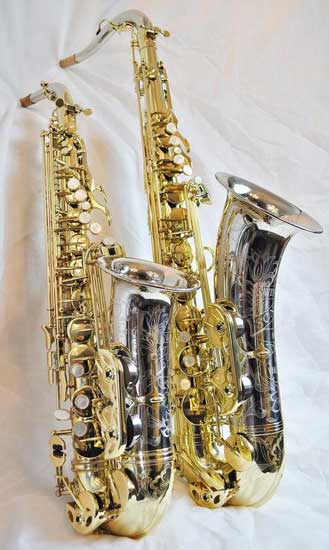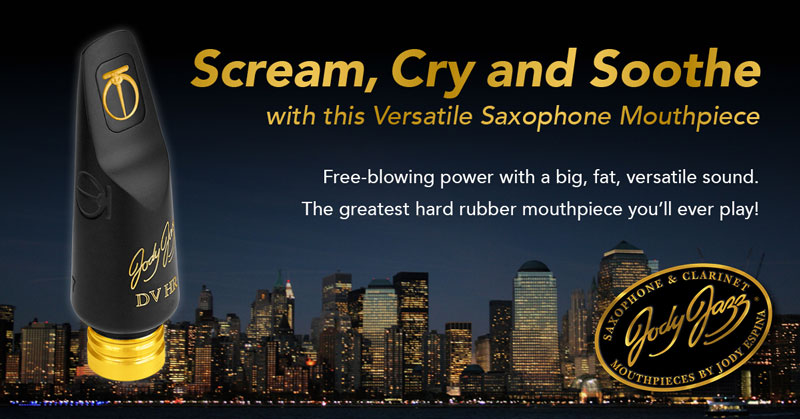How Does Viking’s Newest Saxophone Fit in the Lineage of Classic Horns?
 Introduction
Introduction
I have received emails from various sax players asking me about the Viking line of saxophones and how they play. When I checked out the Viking saxophones website, the various models were based on the Balanced Action, Super Balanced Action, Mark VI, and most recently the King Super 20 Silversonic. Rich Maraday, owner of Viking saxophones, was nice enough to send me a M21 Swing Sonic tenor saxophone, which is one of the newest models he offers and wanted me to test play it and see what I think.
I will be reviewing the Viking M21 Swing Sonic tenor saxophone based on its appearance, build quality, tone & response, action, and intonation.
Appearance
When I first saw the M21 Swing Sonic online, it reminded me of the King Super 20 Silversonic, which is what it was based on, but at the same time this saxophone reminded me of the Yanagisawa T9935 in terms of the overall look.
When I received this saxophone to test play, I noticed the contrast between the nickel silver bell and neck with the brass body. The engraving was very detailed like a vintage Zephyr, a Yanagisawa 9937 Sterling Silver model and a Selmer Balanced or Super Balanced Action model engraving. This M21 Swing Sonic that Rich sent me had key guards modeled after the King Super 20, and Rich added white rollers instead of black rollers which gave the horn a nice touch. The key touches were white mother of pearl which felt and looked great compared to the plastic mother of pearl.
Build Quality
The Viking model saxophones are built in Taiwan. When Rich receives each horn, he play tests each model and then makes adjustments where needed. The Viking M21 Swing Sonic saxophone, like Viking’s other horns, the M58 and M40, has Pisoni Italian pads, metal resonators, blue steeled springs, white mother of pearl, and uses quality brass. When I picked up the M21 Swing Sonic, the horn felt stable and I did not notice any lacquer flaws or quick repair fixes throughout the horn. In terms of the weight of the horn, it felt a bit lighter then my Mark VI tenor.
Here are the product details listed for the Viking M21 Swing Sonic:
- custom made viking solid nickel silver neck under slung octave mechanism with fast taper
- 72% Copper content brass body and bow with minimal post rib construction
- Italian pads with domed metal resonators
- modern keywork
- blue steel springs
- white pearls
- white or black rollers
- Super 20 vintage style key guards, white rollers, and 1950s era guards (option)
Tone & Response
I found the Viking M21 Swing Sonic was free blowing from low Bb to high F#. I found the bottom end to be full and neutral in terms of not too dark or bright, the middle section was also neutral but I found a little bit of resistance, and the upper register leaned towards the brighter side and really cut. I found the tone overall to lean towards a brighter straight ahead sound compared to an edgy dark sound. I believe this horn would fit any genre of music, but many players who play more contemporary music might lean towards this model over the M58 and M40, but its hard to say unless you try all three models.
Action
The action and layout on the Viking M21 Swing Sonic was more similar to that of a Selmer Mark VI than that of the King Super 20 Silversonic. From low Bb to high F#, the action felt tight and fluid. I would have preferred looser action on this horn, but this is my personal preference. In terms of some modifications I would make to the horn would be to add some more cork to the high E key so it does not open as much as well as to open up the D and Eb key a bit. For the most part, I can tell that Rich takes his line of horns seriously and won’t ship out a horn unless the action is setting well throughout the horn.
Intonation
While working thru my overtone exercise I found the Viking M21 Swing Sonic to respond well and play in tune. For myself, I found the low Bb to play a bit sharper than my Mark VI, but adjusting where my mouthpiece sat on the cork corrected this. Since this horn played brighter in the upper stack I had to get used to this compared to my Mark VI. While playing this model over the past couple weeks, I became more comfortable with the horn and was able to adjust quickly.
Final Thoughts
I would have to say I was impressed with the Viking M21 Swing Sonic saxophone. I think Rich gets the idea that saxophone players from a students to professionals are looking for a saxophone that, most importantly, sounds great, feels great, and looks great. The Viking M21 Swing Sonic definitely is tailored to those professional musicians looking for a back up to their Mark VI or as their new main horn that will get them from job to job with no hassle. I would highly recommend checking out Viking saxophones because they come out of the tradition of the great vintage saxophones, and one thing I can say thus far from trying the M21 Swing Sonic is that Rich is offering a solid horn at a very reasonable price (Tenor: $2,799 / Alto: $2,499).
Me Play-Testing the M21 Swing Sonic
To find out more, please visit the Viking website [Sorry(!), but this web page has disappeared since the original publication of this article]. You can also contact Rich through the contact form on the website, and he’ll be more than happy to answer any questions and offer the “inside scoop” on his line.
To learn more about the Swing Sonic, hop over to http://www.viking-instrument.net/Custom-Saxophones-Products.html [Sorry(!), but this web page has disappeared since the original publication of this article].






November 23, 2013 @ 12:01 pm
“Last week, I received an alto and tenor of the M21 model with the nickel silver bell and neck on both. The tenor has the white rollers and the super 20 guards which is pretty cool. I also own the m58 alto and one of the original m40 tenors with a set up from Tenor Madness. I can confidently say that the models have distinctly different tonal colors which gives me great satisfaction. The m21 tenor has a deeper and more direct presence than the m40 which has a sweeter vibe. The m21 alto is actually darker in tone than the m58 alto and reminds me of the solid silver Yanis that I have played in the past. Intonation is absolutely superb on the alto which again compares to the yani. I am equally as satisfied with the intonation on the tenor. The word “slot” comes to mind when playing the tenor as in “The intervals slot really well” meaning the intonation is very, very solid and accurate between the intervals. Lastly, I simply feel good playing these horns from tone to action and they look really hip.”